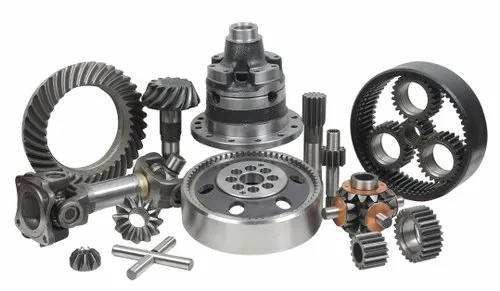The construction industry relies heavily on machinery to complete projects efficiently. When these machines break down, replacing spare parts is a critical decision. Equipment owners often face the dilemma of choosing between OEM (Original Equipment Manufacturer) spare parts and aftermarket spare parts. This article explores the differences between the options and the pros and cons to help you make an informed decision.
Understanding OEM Spare Parts
Definition and Characteristics: OEM spare parts are components manufactured by the original company that built the equipment. They are designed specifically for the machinery, ensuring precise fit and performance.
Benefits of OEM Spare Parts
- Guaranteed Fit and Compatibility: These parts come from the original manufacturer and match the machine’s specifications.
- High-Quality Standards: OEM parts undergo rigorous testing and meet industry standards.
- Reliable Warranty Coverage: Most OEM parts include a manufacturer’s warranty, offering peace of mind.
- Extended Lifespan: These components are built to last, minimizing downtime and repair frequency.
Downsides of OEM Spare Parts
- Higher Cost: OEM parts are often more expensive than aftermarket alternatives.
- Longer Lead Times: Some OEM parts have limited availability, leading to delays in machine repairs.
Understanding Aftermarket Spare Parts
Definition and Characteristics: Aftermarket parts are produced by third-party manufacturers and are designed to be compatible with specific equipment models.
Advantages of Aftermarket Parts
- Cost-Effective: Typically, aftermarket parts are more affordable than OEM counterparts.
- Wider Availability: These parts are manufactured by multiple companies, increasing accessibility.
- Competitive Quality: Some aftermarket brands provide equal or even superior performance compared to OEM parts.
Disadvantages of Aftermarket Parts
- Quality Variability: Not all aftermarket manufacturers adhere to strict quality controls.
- Compatibility Issues: Some parts may not fit perfectly and may require modifications.
- Limited Warranty Coverage: Many aftermarket parts have shorter or no warranty protection.
Cost Comparison
Price Differences Between OEM and Aftermarket
OEM parts generally cost 30-50% more than aftermarket alternatives. This price difference is due to brand reputation, research, and proprietary technology.
Hidden Costs and Savings
- OEM parts may reduce long-term costs by preventing frequent breakdowns.
- Aftermarket parts can provide short-term savings but may need replacement sooner, leading to higher maintenance costs.
Performance and Quality
OEM vs. Aftermarket in Terms of Quality
- OEM parts are designed for optimal performance and durability.
- High-quality aftermarket brands offer similar reliability but require careful selection.
Longevity and Durability Considerations
- OEM parts generally last longer due to strict quality control.
- Premium aftermarket parts can also match OEM longevity but vary by brand.
Availability and Accessibility
Supply Chain Differences
- OEM parts depend on the manufacturer’s supply chain, which can lead to shortages.
- Aftermarket parts are widely available, making them a good alternative in urgent situations.
Delivery Time and Inventory Management
- OEM parts may take longer to arrive, especially for specialized equipment.
- Aftermarket parts have better stock availability, reducing downtime.
Warranty and Support
OEM Warranties vs. Aftermarket Guarantees
- OEM warranties often last 1-2 years with full manufacturer backing.
- Aftermarket warranties vary, with some offering only limited coverage.
Customer Support and Technical Assistance
- OEMs provide direct support and installation guidance.
- Aftermarket manufacturers may offer third-party customer service, which can be less reliable.
Industry Standards and Compliance
Regulatory Approvals and Safety Standards
OEM parts meet strict industry regulations, while some aftermarket parts may lack certification. Always check compliance before purchasing.
Best Use Cases for OEM Parts
- When long-term reliability is a priority.
- For new equipment still under warranty.
- In safety-critical applications where precision is essential.
Best Use Cases for Aftermarket Parts
- When cost savings are a significant factor.
- This is for older equipment where OEM parts are discontinued.
- When availability is crucial for quick repairs.
FAQs
1. Are aftermarket parts as good as OEM parts?
Ans. Some aftermarket parts meet or exceed OEM quality, but research is needed to find reputable brands.
2. Will using aftermarket parts void my warranty?
Ans. It depends on the manufacturer’s policy. Check your warranty terms before installation.
3. Why are OEM parts more expensive?
Ans. OEM parts include research, development, and brand assurance, contributing to higher costs.
4. Can I mix OEM and aftermarket parts?
Ans. Yes, but ensure compatibility to maintain machine performance.
5. Where can I find high-quality aftermarket parts?
Ans. Look for brands with industry certifications and positive reviews.
6. Which is better for resale value, OEM or aftermarket?
Ans. OEM parts generally help retain equipment value better than aftermarket parts.
Conclusion
Choosing between OEM and aftermarket spare parts depends on budget, availability, and equipment needs. While OEM parts ensure quality and reliability, aftermarket parts offer cost-effective and accessible alternatives. Evaluate your specific situation to make the best decision.


